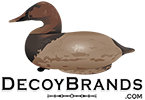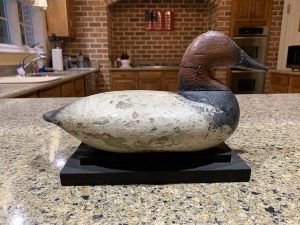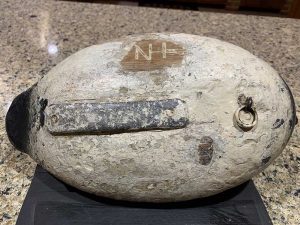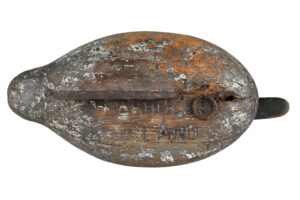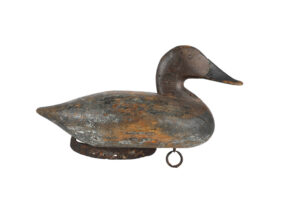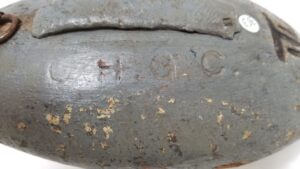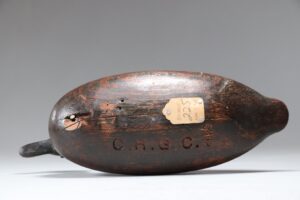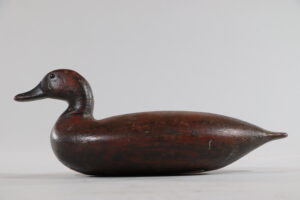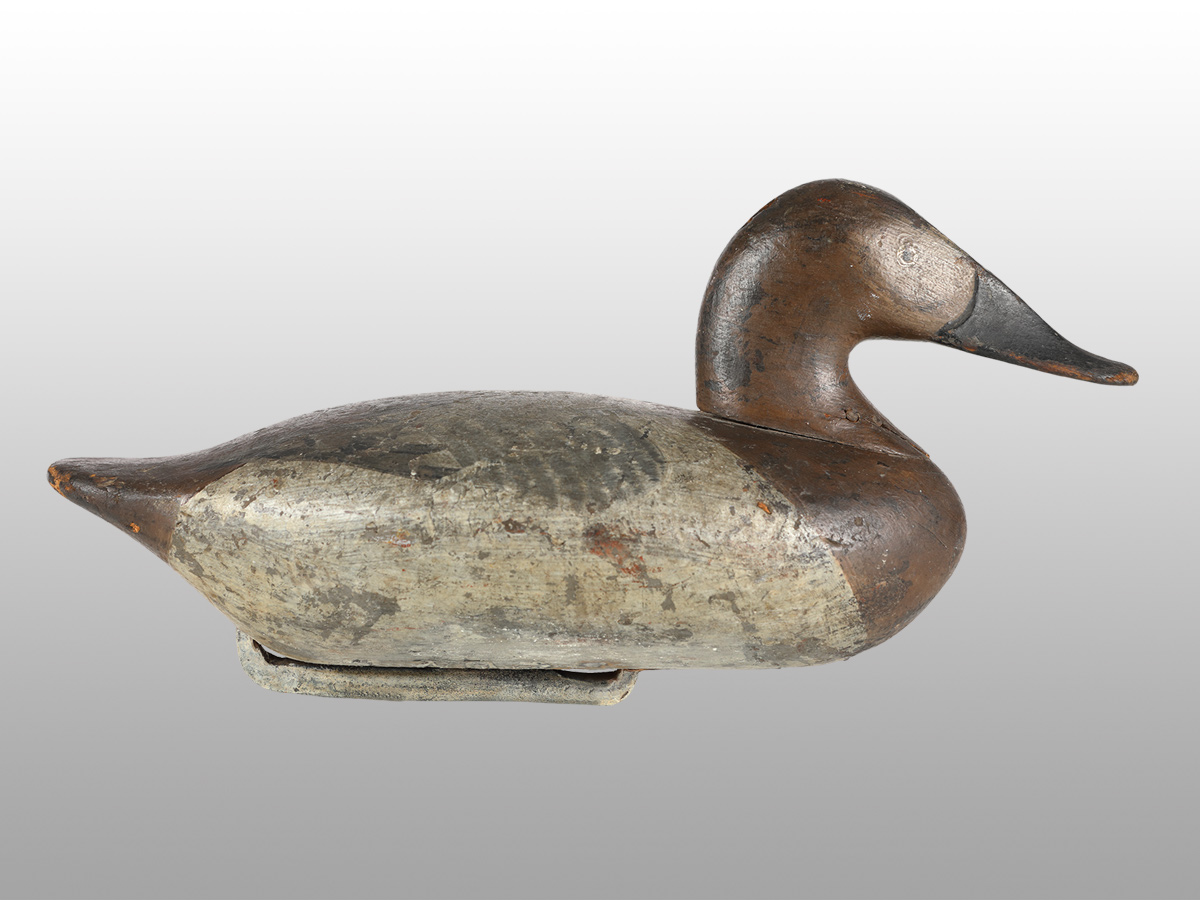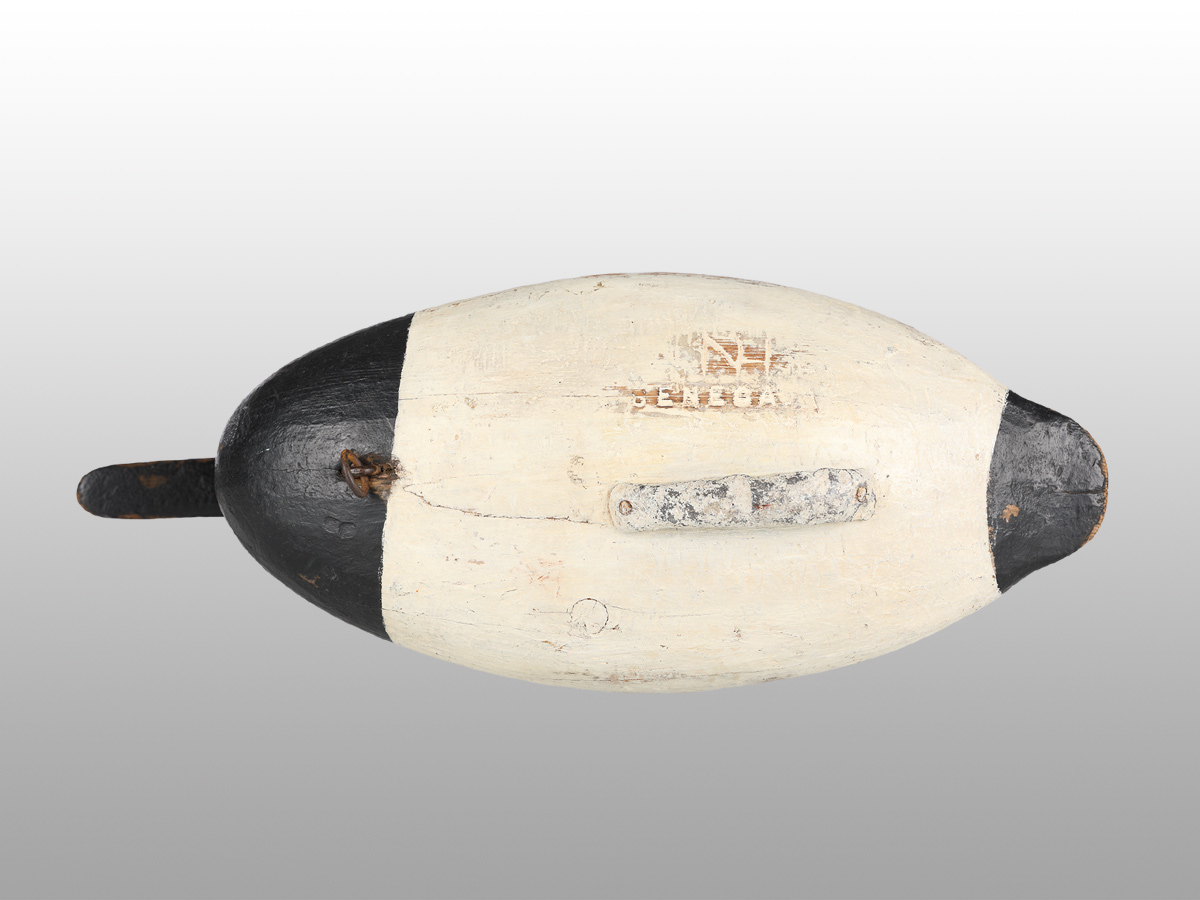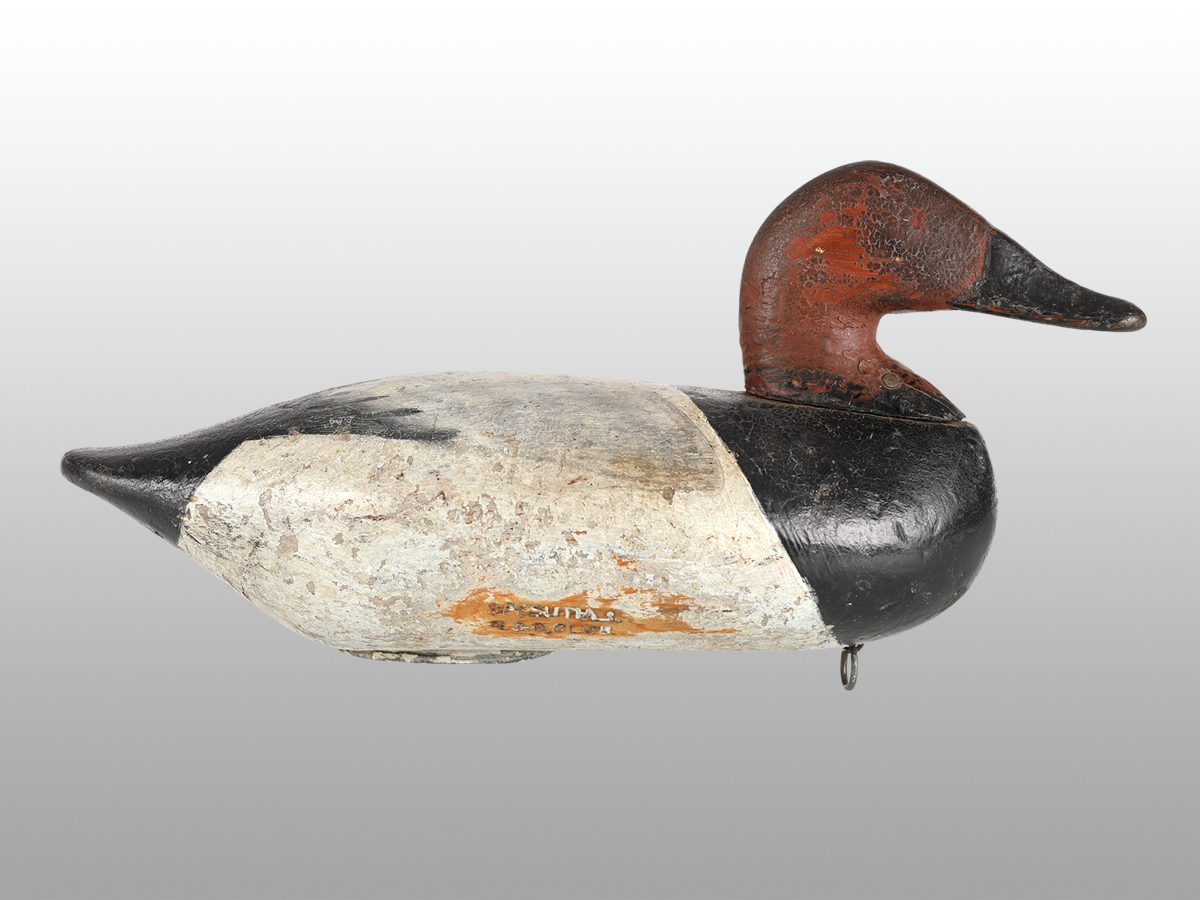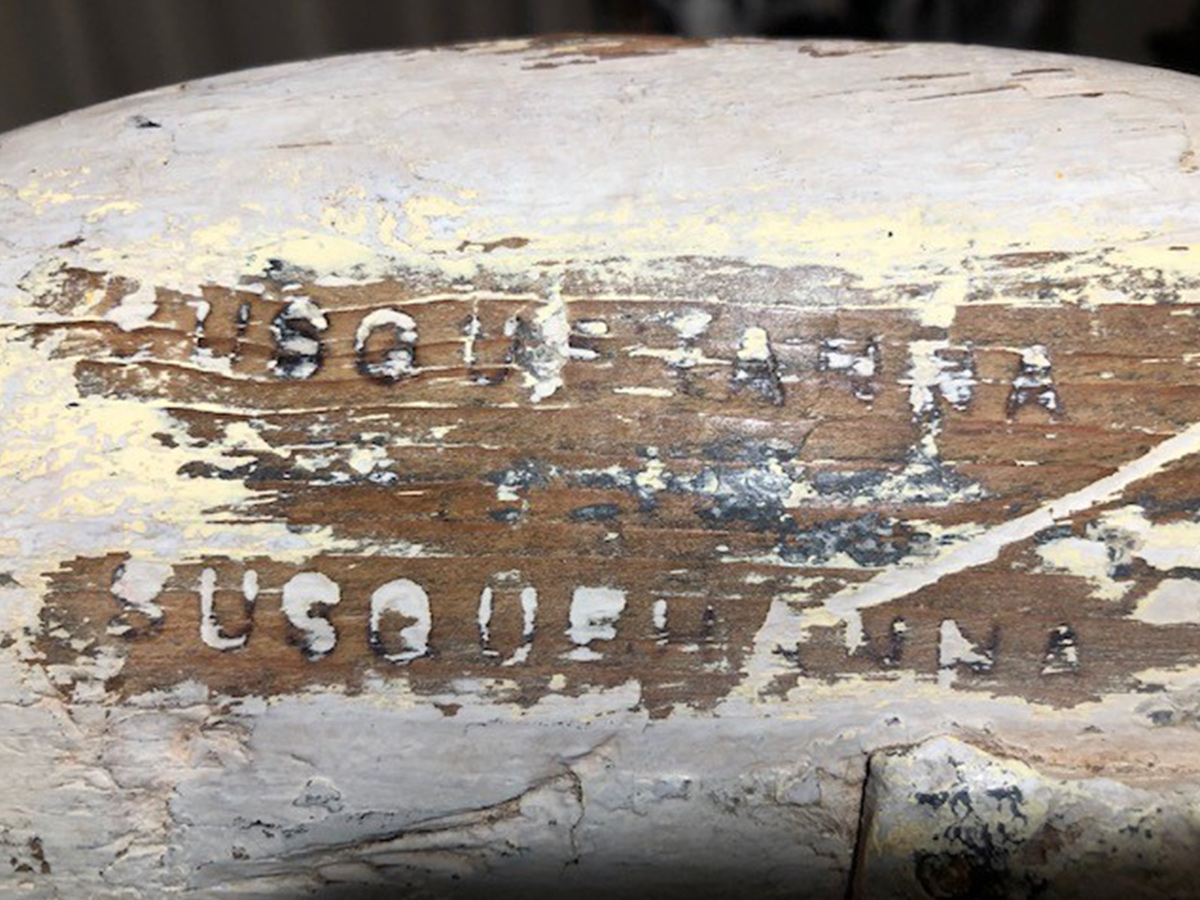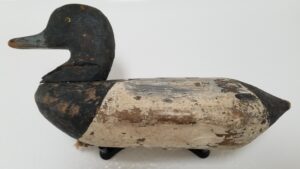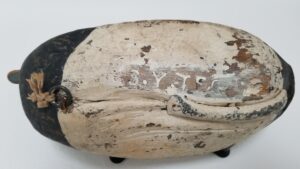UPPER CHESAPEAKE BAY CLUB BRANDS
Upper Chesapeake Bay Club Brands will be listed here.. A-Z order
EDGEWOOD ARSENAL ROD & GUN CLUB
Click on any image to enlarge
PHYSICAL DESCRIPTION OF BRAND:
The Edgewood Rod and Gun Club brand is the branch insignia of the U.S. Army Chemical Corps. The burned insignia/brand consists of a benzene ring, superimposed over two crossed retorts. This insignia was adopted by the newly created Chemical Corps in 1918 and officially approved in 1921. The branding irons used to brand the Club decoys most likely date to the 40s or 50s although the Club predates them. The smaller brand, primarily used on duck decoys, is 1” wide x ½” in height. The larger brand, primarily used on Canada goose decoys, is 3 ½” wide x 1 3/4” in height. My research indicates that the larger brand was used on at least 2 dozen Mitchell duck decoys.
BACKGROUND:
The Edgewood Arsenal Rod and Gun Club was a club that included U.S. Army officers and Department of the Army civilian personnel stationed at the Arsenal as well as their families and guests. The club operated from approximately the 1920s until sometime not long after the Arsenal was combined with Aberdeen Proving Ground in 1971. In examining limited available records, it appears that in the earlier days of the Club, hunting may have been restricted to members of the Officer’s Mess at Edgewood Arsenal. This could also have been due to wartime since these records date to the early 1940s.
The land area that comprised Edgewood Arsenal, now known as Aberdeen Proving Ground South, was previously home to some of the most famous and prestigious waterfowl gunning clubs and private gunning shores of the 1800s and early 1900s. These included: a portion of the Bartlett and Hayward gunning shore on both Lauderick Creek and the Bush River; Maxwell Point, the gunning shore of John Cadwalader who owned the majority of the Gunpowder Neck land; the Philadelphia Ducking Club located at the mouth of King’s Creek on the Bush River; the Hurst family gunning shore on the Bush River; the Sunshine Club of which little is known at this time; the San Domingo Farm Club between Reardon Inlet and Canal Creek on the Gunpowder River; the Grace’s Quarter Club on the western shore of the Gunpowder River; and finally, the famous Carroll’s Island Ducking Club at the mouth of the Gunpowder River fronting the Chesapeake Bay. Most of these gunning shores were available to the members of the Edgewood Rod and Gun Club although some areas may have been closed down periodically due to testing and other military operations. It’s also been directly related to me that Poole’s Island, although not generally open to the Club at large, was gunned on a limited basis at the pleasure of the Commanding General, Edgewood Arsenal.
The majority of the decoys in the Club rig were made by R. Madison Mitchell and Paul Gibson. Gibson also served with the Fire Department on Edgewood Arsenal, and retired as its Chief in 1965. Decoys by other Upper Chesapeake Bay makers may also be found with this brand. These other decoys came to be part of the rig in a couple of ways. Members could draw 50, 100, or 150 decoys at the beginning of the season. They were turned-in in groups of 50 at a time. If a decoy broke away in rough weather, it was rarely recovered. If decoys had been lost, members replaced them with another decoy. When the Club would purchase new decoys for the rig, members would sometimes trade an old decoy of their own for a new decoy from the Club rig. The Club repainted the rig in the off-season and if a decoy was found to be without a brand (usually old birds added as previously described), it was branded with the Club brand. The club had two branding irons- a smaller iron for duck decoys, and a larger iron for goose decoys. All of the examples of Canada goose decoys with this brand that I’ve seen are Gibson geese. William (Bill) Kennedy, who tended to the rig in the off-season for many years, told me that he had personally branded a couple of dozen Mitchell duck decoys with the larger brand as well.
The Edgewood Arsenal Rod and Gun Club brand has acquired a number of names in the decoy collecting community that are technically and/or historically incorrect. These include: the “Poison” brand, the “Skull and Crossbones” brand, and the “Aberdeen” brand. Additionally, this brand has been referred to as the Ordnance Corps brand. It’s easy to understand why this occurred given the histories of Aberdeen Proving Ground and Edgewood Arsenal. Aberdeen Proving Ground was the home of the Army Ordnance Corps, and Edgewood Arsenal was the home of the Army Chemical Corps. The two bases merged in 1971. There was no Rod and Gun Club (or other officially recognized club) using branded decoys on Aberdeen Proving Ground prior to the merger. Reports of decoys branded with the Ordnance Corps insignia have been noted by collectors, but I’ve never seen an example in over 20 years. If there are decoys branded with the Ordnance Corps branch insignia (metal shell and flame), the brand is more than likely a personal brand of an officer of the Ordnance Corps. It’s also been proffered that decoys by Paul Gibson branded with the “FD” brand were from a fire department club on Edgewood Arsenal. Bill Kennedy, a former member of the Club whose father was a principal volunteer with the Club for approximately 30 years, firmly stated that there was no other club on Aberdeen Proving Ground or Edgewood Arsenal using branded decoys.
Other Brands on this decoy: John Graham drake Canvasback duck decoy with Edgewood Arsenal Rod and Gun Club brand and Nicholas Hyland (Conjoined “NH”) brand. Hyland was a carpenter and hunter from the Elk Neck area of Cecil County, MD.
THIS BRAND HAS BEEN IDENTIFIED ON THE FOLLOWING DECOYS:
| MAKER | SPECIES | SEX | OTHER BRANDS ON DECOY |
|---|---|---|---|
| Madison R. Mitchell | Canvasback | Drake | |
| Madison R. Mitchell | Canvasback | Hen | |
| Madison R. Mitchell | Redhead | Drake | |
| Paul Gibson | Redhead | Hen | |
| Paul Gibson | Goose | N/A | |
| Unknown Cecil County Carver | Canvasback | Drake |
REFERENCES/SOURCES:
Personal collection including maps; duck and goose decoys; photos; and copies of Club records. Personal interviews with former Club members and DA Civilian employees including: William (Bill) Kennedy (Dependent / Club member 1955-1968) , Steven English (DA Civilian / hunted Edgewood 1973-2004), and William Brankowitz (DA Civilian / authority on Chemical Corps and Edgewood history). Additional information and interviews with the Aberdeen Post Historian, Jeffrey Smart, contributed to this narrative. Nicolas Hyland’s obituary published in the Cecil Whig.
INITIAL CONTRIBUTOR:
Kevin S. Peel
ADDITIONAL CONTRIBUTORS:
CARROLL’S ISLAND DUCKING CLUB
Click on any image to enlarge
PHYSICAL DESCRIPTION OF BRAND:
The Carroll’s Island brand is a burned brand comprised of two lines of block style capital letters measuring 4 5/8″ in length (top line) x 1 7/8″ in height (two lines).
BACKGROUND:
The Carroll’s Island Ducking Club, the most famous of Maryland ducking clubs, officially dates to 1851. The Island is located at the mouth of the Gunpowder River to the west; the Chesapeake Bay to the south, Seneca Creek to the east, and the confluence of Salt Petre and Dundee creeks to the north. References to leased gunning and some form of club on Carroll’s Island date back to at least 1829. Much of the early gunning was pass shooting using large bore fowling pieces of 4 and 8 bore over the famous Carroll’s Island Bar, a long narrow peninsula, that extended from the Island west into the Gunpowder River. The Bar is now a small island unto itself due to storms that washed away the middle portion of the Bar. Records indicate that shore blinds and decoys were also used extensively by the Club. Decoys bearing this brand are primarily John “Daddy” Holly decoys. Many of these branded decoys have been re-headed as they’re early and were gunned hard.
THIS BRAND HAS BEEN IDENTIFIED ON THE FOLLOWING DECOYS:
| MAKER | SPECIES | SEX | OTHER BRANDS ON DECOY |
|---|---|---|---|
| John “Daddy” Holly | Canvasback | Hen | QUINN, and unknown brand |
| John “Daddy” Holly | Canvasback | Drake | |
REFERENCES/SOURCES:
C. John Sullivan, Chesapeake Bay Retrievers, Decoys, & Long Guns, Tales of the Carroll’s Island Ducking Club
INITIAL CONTRIBUTOR:
Kevin S. Peel
ADDITIONAL CONTRIBUTORS:
C.H.G.C.
Click on any image to enlarge
PHYSICAL DESCRIPTION OF BRAND:
C.H.G.C. is a burned brand in block letters with period after each letter, all CAPS. Brand is 1/2″ high x 3 1/2″ wide.
BACKGROUND:
C.H.G.C. is the brand of the Charter Hall Gun Club that was established near Perryville, Cecil County MD in 1889 by 16 sports from Philadelphia. The men bought the Chowder Hall farm at public auction. Henry Stump Coudon (1824-1913), father of Cecil County decoy maker Joseph Coudon of Henry (1860-1947), was the owner at the time.
THIS BRAND HAS BEEN IDENTIFIED ON THE FOLLOWING DECOYS:
| MAKER | SPECIES | SEX | OTHER BRANDS ON DECOY |
|---|---|---|---|
| Ben Dye | Redhead | Drake | A.H.TAYLOR, JTL (or JLT) |
| John Graham | Teal | ||
REFERENCES/SOURCES:
Sullivan, C. J., Waterfowling on the Chesapeake, 1819-1936, The Johns Hopkins University Press, 2003
INITIAL CONTRIBUTOR:
Steven Brown
ADDITIONAL CONTRIBUTORS:
Michael Daley
RSDFC
Click on any image to enlarge
PHYSICAL DESCRIPTION OF BRAND:
RSDFC is a burned brand identifying decoys belonging to the San Domingo Farm Club. The brand consists of 5 block letters: RSDFC. The R is for Charles Raymond, the president of the club; and this letter is often not as clear as the other letters of the brand. The “S” is backwards. Each letter is 3/8” wide and ¾” tall; the brand overall is 3 ¼”.
BACKGROUND:
The club was was formed by a group of wealthy gunners from New York and Maryland. They leased land from John Cadwalader on the Gunpowder River, north of Maxwell’s Point. The club had a three-story, well-appointed house and retained extensive leases on waterfront property in the area.
THIS BRAND HAS BEEN IDENTIFIED ON THE FOLLOWING DECOYS:
| MAKER | SPECIES | SEX | OTHER BRANDS ON DECOY |
|---|---|---|---|
| John “Daddy” Holly | Canvasback | Hen | |
| James Holly | Canvasback | Drake | |
REFERENCES/SOURCES:
. John Sullivan, Waterfowling the Chesapeake, 1819-1936 (The Johns Hopkins University Press, 2003)
INITIAL CONTRIBUTOR:
Darrell Hagar
ADDITIONAL CONTRIBUTORS:
SENECA
Click on any image to enlarge
PHYSICAL DESCRIPTION OF BRAND:
SENECA is a burned brand identifying decoys belonging to the Seneca Point Club. It consists of six block letters, each one 5/16″ high by 1/4″ wide; overall, the brand is 5/16″ X 2 1/4″.
BACKGROUND:
Recorded deeds for the property (which is between Charlestown, MD, and Carpenter’s Point on the North East River) go back to the early 1700’s. The property was purchased by a group of 12 men and, in 1868, the Maryland legislature approved a bill to allow the Seneca Point Club of Cecil County to choose directors who lived out-of-state. The club had over 1,000 acres, a mansion with elaborate grounds and gardens, and many out buildings. The club was dissolved in 1889.
THIS BRAND HAS BEEN IDENTIFIED ON THE FOLLOWING DECOYS:
| MAKER | SPECIES | SEX | OTHER BRANDS ON DECOY |
|---|---|---|---|
| John Graham | Canvasback | Drake | NH for Nicholas Hyland |
REFERENCES/SOURCES:
Rod Wittstadt, www.CecilCountyDecoys.com
INITIAL CONTRIBUTOR:
Darrell Hagar
ADDITIONAL CONTRIBUTORS:
SPESUTIA ISLAND ROD & GUN CLUB
Click on any image to enlarge
PHYSICAL DESCRIPTION OF BRAND:
The Spesutia Island Rod and Gun Club brand is a burned brand that measures 1 ¾” long x ¾” in height. The brand abbreviates the Club’s name in all capital letters as follows:
SPESUTIA I.
R&G CLUB
BACKGROUND:
The Spesutia Island Rod and Gun Club was incorporated on August 21, 1890 in New York. The membership consisted of some of the wealthiest men in America. The first year trustees of the club were: J. R. Maxwell, George B. Post, Archer N. Martin, Adolph de Bary, Eugene L. Maxwell, Henry W. Maxwell, Henry S. Manning, George A. Evans, Henry A. V. Post, Edgar S. Auchincloss, and Hugh D. Auchincloss. The club later counted J. Pierpont Morgan among its members. The Club operated from 1890 until 1942 when the Army leased the Island to conduct rocket testing, and purchased the entire Island in 1945.
THIS BRAND HAS BEEN IDENTIFIED ON THE FOLLOWING DECOYS:
| MAKER | SPECIES | SEX | OTHER BRANDS ON DECOY |
|---|---|---|---|
| James T. Holly | Canvasback | Drake | |
REFERENCES/SOURCES:
Personal collection and research.
INITIAL CONTRIBUTOR:
Kevin S. Peel
ADDITIONAL CONTRIBUTORS:
SUSQUEHANNA
Click on any image to enlarge
PHYSICAL DESCRIPTION OF BRAND:
The brand appears to be a hot brand with 1/4 inch tall letters in all caps, the length is right at 6 inches long. It appears that the letter spacing does diminish slightly towards the end of the brand.
BACKGROUND:
The Gunning Scow was one of the earliest scows working the Susquehanna Flats dating back to the 1880’s. The brand is highly sought after.
The Susquehanna brand is often imitated using stamped letters since it is simple block style lettering. Examples have surfaced with the name Susquehanna spelled incorrectly.
THIS BRAND HAS BEEN IDENTIFIED ON THE FOLLOWING DECOYS:
| MAKER | SPECIES | SEX | OTHER BRANDS ON DECOY |
|---|---|---|---|
| John Daddy Holly | Canvasback | Drake | This Decoy had only one exposed brand when purchased however I was able to locate and expose a second Susquehanna brand. |
REFERENCES/SOURCES:
Waterfowling on the Chesapeake- Canvasback Magazine – Havre De Grace Decoy Museum
INITIAL CONTRIBUTOR:
Gary Armour
ADDITIONAL CONTRIBUTORS:
S. Y. TECH
Click on any image to enlarge
PHYSICAL DESCRIPTION OF BRAND:
This brand is in block letters, all CAPS, with periods after S and Y; brand is 1/2″ high x 3 1/2″ wide
BACKGROUND:
S. Y. TECH is the brand for the steam yacht Tech, known to be in operation in the early 1900s. The owner of record was T. Coleman du Pont.
THIS BRAND HAS BEEN IDENTIFIED ON THE FOLLOWING DECOYS:
| MAKER | SPECIES | SEX | OTHER BRANDS ON DECOY |
|---|---|---|---|
| Unknown | Bluebill | Drake | None. |
REFERENCES/SOURCES:
- Sullivan, C. J., Waterfowling on the Chesapeake, 1819-1936, The Johns Hopkins University Press, 2003
- Tragakis, C., On Board the Upper Chesapeake’s “Floating Clubhouses”, Decoy Magazine, Sundance Press, September/October 2017
INITIAL CONTRIBUTOR:
Steven Brown
ADDITIONAL CONTRIBUTORS:

